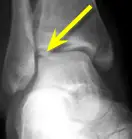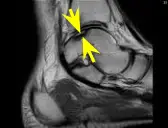talar dome fracture
AUTHOR: Marc Mitnick DPM home --> talar dome fractureosteochondral defect or osteochondritis dessicans
WHAT IS A TALAR DOME FRACTURE
One of the bones comprising the ankle is the talus bone which forms part of the foot. It forms the “floor” of the ankle joint. It derives the name "dome" because it sits cradled on top of the calcaneus with the top portion of the bone forming a dome like structure to allow for the up and down motion of the foot. Ligaments attach the talus bone to the tibia and fibula bones to complete the ankle joint.
In a severe ankle sprain, usually the medial and lateral ankle ligaments bear the brunt of the trauma, but sometimes the sprain may be so severe that the talus bone is displaced resulting in trauma to the bone and in many cases may be severe enough to cause a fracture within the talus.
mechanism of injury that causes talar dome fractures
In the majority of cases there is a severe inversion sprain along with a resulting dorsiflexion of the foot (the ankle turns inward and at the same time the foot is jerked upwards). Usually the top or dome is affected and thus we end up with a fracture of the dome. The incidence of this type of fracture in ankle sprains is estimated to be in the range of 2-6%. Since the talar dome is made of cartilage (which is what allows the foot to bend up and down smoothly) if it does not heal properly a small piece of cartilage may actually break off creating a defect in the otherwise smooth pearly nature of cartilage. The broken piece of cartilage may then “float” in the ankle joint acting as a foreign body which can be irritating to the joint and cause pain.
symptoms of a talar dome fracture
- pain in the ankle, worse when ambulating or standing for long periods of time compared to periods where the patient is not doing much walking.
- clicking type sensation in the ankle during ambulation.
- locking of the ankle
- sensation that the ankle is going to give out on them and they do not feel secure to bear weight on the ankle.
- Swelling is a normal complaint in these conditions and the amount of swelling is usually proportional to the amount of activity one undertakes.
diagnosis of talar dome fracture

|
Diagnosis of talar dome fractures can be difficult to make as it is quite often overlooked when a patient complains of ankle pain particularly if the ankle sprain was not considered serious.
An xray would be the first diagnostic test performed and often it is a good idea to take the same views of the other ankle for comparison purposes. If an xray proves to be uneventful and your doctor suspects a talar dome fracture, an MRI or CT scan may have to be performed for a more definitive view of the talus.
Once in a while, a local anesthetic may be injected directly into the joint, in an effort to see if the pain is coming from deep in the joint. If relief occurs, it may indicate the possibility of a talar dome fracture. It should be noted for clarification purposes that these type of talar dome fractures that create a loose body of cartilage are also known as an osteochondral defect.

|
TREATMENT OF TALAR DOME FRACTURES
Treatments for this fracture are predicated on the severity of the defect along with the age and activity of the patient.
- The simplest treatment is to place the patient in a cast to keep the ankle joint from moving and allowing the defect to heal. The patient may or may not be able to bear weight, at the discretion of the doctor.
- Oral anti-inflammatory medication or pain medication may be prescribed to reduce the discomfort associated with this condition.
- Once healing has occurred, physical therapy may be helpful to restore range of motion in the affected ankle joint. During this period and possibly beyond, the patient may wear an ankle brace to better stabilize the joint and hopefully prevent further injury.
- In cases where the talar dome defect is too far into the joint and thus will never heal back on to the dome, surgical intervention may be necessary to remove the defect. Surgical treatment may involve a simple arthroscopic procedure to remove the bone chip to more complicated situations where there is open reduction where the ankle joint is opened, the talar defect is identified and put back into place and held there with internal fixation.
The problem with a talar dome fracture, particularly one that does not heal properly is that it further inflames the joint causing more damage to the ankle joint resulting in a more arthritic ankle. This situation could result in further pain, more limitation of motion in the joint and chronic swelling. One of the complications of improper removal or poor re-positioning of the talar defect is that the bone chip may undergo avascular necrosis which means the bone chip actually dies due to lack of circulation and most certainly will then act as an irritant within the joint.
REFERENCES


Recent Articles
-
Vitamin D impact on health
Feb 06, 23 07:17 PM
Researchers are suggesting that the effectiveness of Vitamin D in fighting and preventing disease is predicated on a persons body mass index (BMI). The thinner the person the greater the positive impa… -
Foods to speed up healing
Feb 01, 23 02:41 PM
One of the best ways to help yourself heal faster after surgery is to eat well. Getting the proper nutrition will provide your body with the essentials it needs to promote healing. Here is a suggestio… -
Cancer and Type 2 Diabetes
Jan 25, 23 04:52 PM
An article revealing that older type 2 diabetics have a higher incidence of cancer then non-diabetics. It is suggested that cancer may surpass CVD as the number one cause of death in older diabetics. -
Does glucosamine or MSM reduce arthritis pain?
Jan 22, 23 01:41 PM
A good review of the possible benefits to taking glucosamine, chondroitin or MSM for arthritis. Always beware of the possible side effects of over the counter supplements. -
shin splints
Jan 18, 23 05:12 PM
A great review on the various causes of shin splints, along with treatment options. -
Whats new in skin cancer?
Jan 15, 23 08:32 PM
A presentation of newer skin protection combinations in an effort to better protect the skin from the hazards of sun exposure. -
Causes and risk factors of warts
Jan 14, 23 05:02 PM
A good review of the causes of warts and protective measures you can take to prevent developing them. -
Do chronic wounds need to be dressed daily?
Jan 11, 23 02:18 PM
Because of supply chain shortages as well as staffing shortages particularly during the pandemic, many institutions extended the time between dressing changes for chronic wounds. Is this really the be… -
Food choices that raise your risk of type 2 diabetes
Jan 08, 23 10:07 AM
A good review of how blood sugars can become elevated and the harm that can do. Certain food groups have a tendency to raise your blood sugars and should be avoided. -
Outcome stats from Scarf bunionectomy
Jan 03, 23 03:04 PM
The Journal of Foot and Ankle Surgery recently reported a meta analysis of outcomes in 1583 Scarf bunionectomies that met their inclusion criteria. Adverse events did not seem to be any better or wors…